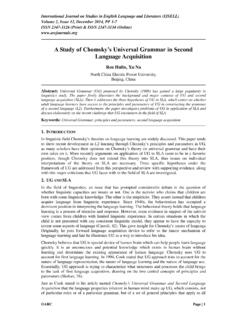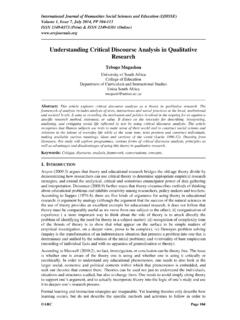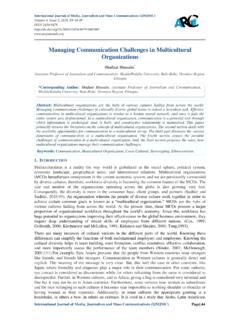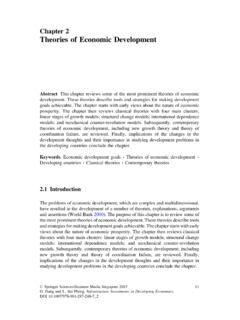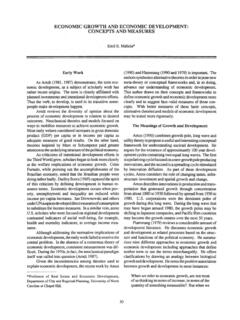Transcription of The Harrod Domar Growth Model and its Implications for ...
1 International Journal of Humanities Social Sciences and Education (IJHSSE) Volume 6, Issue 4, April 2019, PP 11-17 ISSN 2349-0373 (Print) & ISSN 2349-0381 (Online) International Journal of Humanities Social Sciences and Education (IJHSSE) Page | 11 The Harrod Domar Growth Model and its Implications for economic Development in Vietnam Le Ngoc Thong*, Nguyen Thi Hao Teacher at the National Economics University, Vietnam 1. INTRODUCTION In the current context, the issue of economic Growth and development is an urgent issue for developing countries. Vietnam is also in the vortex, where the use of theoretical models of Growth is relatively new and difficult. But according to the requirements of international economic integration, the process is considered as an indispensable activity in policy making.
2 Many models of economic Growth must be considered, including the Growth Model Harrod - Domar . 2. METHODOLOGY The paper uses a combination of methods: theoretical research, document research, practical research .. to perfect theories and draw scientific conclusions. 3. RESEARCH RESULTS The Inheritance in the Flow of History of economic thought The history and development of theories of economic Growth and development have gone through four stages: (i) From the 18th to the 50th centuries, the prevailing view of " Capital accumulation "with the classic Growth Model of A. Smith and Growth Model Harrod - Domar ; (ii) From the late 1950s to the early 1960s, the prevailing view of the "technology" theory with the Growth models of Robert Slow and Danison; (iii) From the late 1960s to the 70s of the twentieth century, the prevailing view of the "human capitalist" theory of the Growth Model of Theodore Schultz; (iv) To this day, the prevailing trend of "new Growth " with the Growth Model of RomoRucas and Scost[6; 316].
3 Thus, at each stage there are the theories and the ability to adapt accordingly. In particular, attention is paid to applications from Growth Model Harrod Domar . Based on Keynesian ideas, in the 1940s, Growth Model Harrod -Domaremerged and was widely used in developing countries to examine the relationship between Growth and capital needs. Growth Model Harrod - Domar "is a synthesis of the results of two consecutive independent studies by British economist Roy Harrod with the" Theory of Dynamic Theory "(1939) and the American economist Polish author EvseyDomar with "Capital Expansion, Growth and Jobs" (1946) "1. The starting point for the construction (H) is the viewpoint of J. Keynes. The basic ideas of J. Keynes: 1 Based on Document 1 Abstract: By synthesizing a suitable research methodology, the paper examines the basics of the Harrod - Domar Growth Model and adds those Model applications to the analysis of national economic development.
4 Thereby, it is suggested to use Harrod - Domar Model in the orientation of the national economy in Vietnam Keywords: Harrod - Domar , ICOR, economic theory, economic Growth and development Model , economic development, economic Growth , policy application, capital *Corresponding Author: Le Ngoc Thong, Teacher at the National Economics University, Vietnam The Harrod Domar Growth Model and its Implications for economic Development in Vietnam International Journal of Humanities Social Sciences and Education (IJHSSE) Page | 12 The notion of equilibrium below potential and the role of expenditure (aggregate demand): "The economy can reach and maintain a balance at a certain level of output"2. (see picture) Fig1: Relations supply - demand LRAS: Potential output level (Y *) SRAS: Actual output level (Y ) According to J.
5 Keynes, the balance of the economy is always below potential; Actual yield is Y <Y *; The length (Y - Y *) is the recession of the economy. J. Keynes appreciates the role of aggregate consumption factors. Increasing aggregate demand will reduce the recession, and the income of the economy will increase - Investment ideas create income effect. According to J. Keynes, spending on investment plays the most positive role - generating revenue More specifically, J. Keynes identifies investments with savings (S = I); Investment decides the size of the job, and on the other hand, J. Keynes also points out that the investment volume depends on the loan interest rate and the marginal effectiveness of the amount of capital. Hence, Harrod said that the Growth rate of the economy depends on the total savings and the relationship between capital and output.
6 While Domar develops the idea of the role of expenditure for investment in " economic Growth theory": Investment enhances the capacity of the economy (I = K). "Savings is the source of today's investment and investment, which is the basis of tomorrow's rising production capital and rising production plays a direct role in increasing the size of the income economy 3. At the same time, Harrod proposed the premise: (i) total savings by total investment; (ii) inputs K, L are variables; (iii) K-L graduation rate is constant; (iv) Population, technology and labor saving have a constant increase Harrod - Domar Model on the role of resource factors in growth4 The Factors that Directly Affect Growth With the abstraction method, Harrod - Domar has fixed the technology, so economic Growth depends on three factors: capital (K), labor (L), and resources (R) Y = f (K, L, R) R, L are the resource factors used on the basis of creating an increase in production capital (K).
7 Here the relationship between Growth and capital needs to be considered. Addressing this relationship needs to address the relationship between savings (S), investment (I), productive capital (K) and production capacity (Y). According to Harrod - Domar , the relationships are as follows: 2 Based on Document2 3 Based on Document1 4 Based on Document7 The Harrod Domar Growth Model and its Implications for economic Development in Vietnam International Journal of Humanities Social Sciences and Education (IJHSSE) Page | 13 + S is the source of the investment (I) + I creates the K of the later period + K directly creates Y of that period The basic argument in this Model is: Saving and investing creates increased capital and production capital is the source of economic Growth or a determinant of economic Growth .
8 As capital changes, national output changes accordingly ( K) ( Y) Increased capital is due to investment activities: I = DK The Relationship between Capital Increase and Output For this relationship, one uses the ICOR(Incremental Capital - Output Rate) increment. Then, kt (ICOR) = Kt / Yt - Factors affecting the ICOR: (i) Technical characteristics of production capital; (ii) Level of resource scarcity; (iii) effective management and use of capital; .. The Relationship between Growth Rate (G) and Saving Rate (S) and Investment (I) gt = Yt / Yt 1 gt = Kt / (k. Yt 1) Kt = It 1 = St 1 gt = It 1/ (k. Yt 1) = St 1 / (kt . Yt 1) s is the cumulative rate in GDP and the cumulative level is S: s = S/Y should be gt = st 1/ kt Conclusions from the Harrod - Domar Model : Simultaneous economic Growth with a saving rate and an inverse with the ICOR.
9 In other words: Growth rate always depends on saving and ICOR. Here are three Growth rates: - Guaranteed speed: gw = s (expected) / k (expected) - Actual speed: gr = s (expected) / k (actual) - Natural speed (gf) in terms of reaching the potential level. From that reasoning, in the Growth Model Harrod - Domar , it refers to the concept of the golden age: gw = gr = gf That is the balance between the three Growth rates mentioned above5. Limitations of Growth Model Harrod - Domar Simplification in Growth research, giving insufficient arguments: economic Growth is only due to investment and has ignored the following: (i) Inefficient investment will not lead to Growth ; (ii) Growth using alternative solutions without using investment solutions; (iii) Investments to a certain degree will be subject to a gradual decrease in income rules Models that can not cope with difficulties in developing countries are difficult to cushion, which can have the following consequences: (i) the imbalance between accumulation and consumption; (ii) Dependent on loans; (iii) The government becomes a big debtor and risk of bankruptcy.
10 5 Based on Document2 The Harrod Domar Growth Model and its Implications for economic Development in Vietnam International Journal of Humanities Social Sciences and Education (IJHSSE) Page | 14 4. POLICY APPLICATIONS OF THE Harrod - Domar Model IN VIETNAM Modeling in economic Growth Planning Apply the Model in economic Growth planning with the main contents: determine the Growth target and the need for investment capital needed to achieve the set objectives. * Guaranteed Growth planning (gk) (determines Growth targets) gk= s0 / kk gk - Growth rate of the planned period s0 - Original Savings Rate kk - coefficient ICOR periodic plan Steps to proceed: Step1: ICOR forecasts, this step is conducted on the basis of the ICOR changes over the years, using the regression Model , econometrics in combination with the forecasts on the development of the department.
